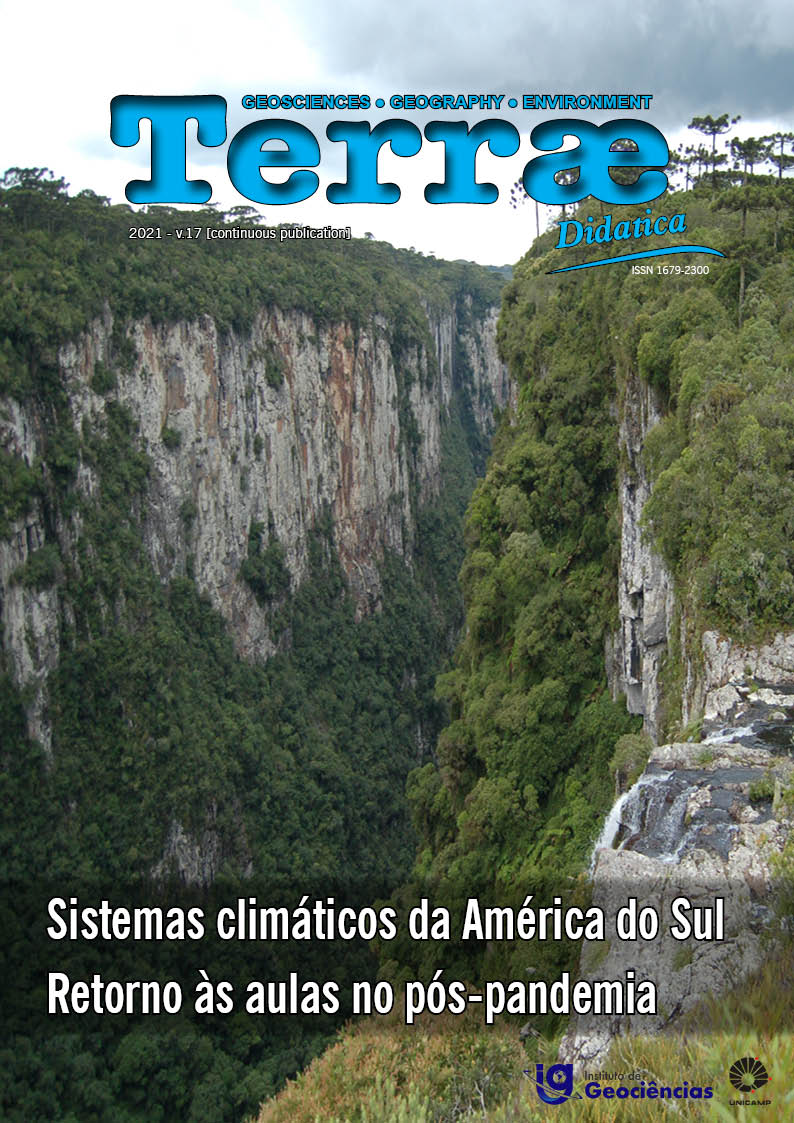Abstract
The approaches of Geosciences in Early Childhood Education are incipient due to the lack of knowledge of the teacher, both on the contents of Geosciences, and on the real learning needs of the child arising from his/her own development. This last aspect is particular to each child and, therefore, distinguishes children of the same age group. This article strongly encourages the development of Geosciences activities in Early Childhood Education, but there are some requirements: (i) considering the development phase to determine the learning objective; (ii) adopting the concepts in Geosciences as a background; and (iii) planning the execution in accordance with the principles of the Universal Learning Design, so that all children, regardless of the stage of development they are in, are able to carry them out with peace of mind. The article is the result of a discipline called “Special Topics in EHCT: Teaching and History of Earth Sciences in an inclusive perspective for people with disabilities”, Unicamp, SP.
References
Bransford, J. D. (2007). Como as pessoas aprendem: cérebro, mente, experiência e escola. Editora Senac São Paulo. 381p.
Brasil. Ministério da Educação. (1999). Diretrizes Curriculares Nacionais para a Educação Infantil (DCNEI). Resolução CNE/CEB 5/2009. Brasília: DOU 18.12.2009.
Brasil. Ministério da Educação. Secretaria de Educação Básica. (2012). Brinquedos e brincadeiras de creches: manual de orientação pedagógica. Brasília: MEC/SEB. 158p.
Brasil. (2016). Lei 12.796/16. Marco Legal da Primeira Infância. Brasil: DOU 09.03.2016. Disponível em: http://www.planalto.gov.br/ccivil_03/_ato2015-2018/2016/lei/l13257.htm. Acesso em: 06 .02. 2020.
Brasil. Ministério da Educação. Secretaria de Educação Fundamental. (2018). Base Nacional Comum Curricular. Brasília: MEC/SEF. Disponível em: http://basenacionalcomum.mec.gov.br/. Acesso em: 31.12. 2020
Bacci, D. L. C. (2009). A contribuição do conhecimento geológico para a Educação Ambiental. Pesquisa em Debate, Edição 11, 6(2), 1-24
Bruner, J. (2002). Acción, Pensamiento y Lenguaje. 6 ed. Madrid: Alianza Editorial. 232p.
Devlin, K. (2010). The mathematical brain. In: Souza, D. A. (Org.). (2010). Mind, brain, and education: neuroscience implications for the classroom. Bloomington: Solution Tree Press. p. 163-178.
Dodick, J., Orion, N. (2003). Cognitive factors affecting student understanding of geologic time. Journal of Research in Science Teaching: The Official Journal of the National Association for Research in Science Teaching, 40(4), 415-442. doi: 10.1002/tea.10083.
Ernesto, M., Cordani, U. G., Carneiro, C. D. R., Dias, M. A. F., Mendonça, C. A., & Braga, E. D. S. (2018). Perspectivas do ensino de Geociências. Estudos Avançados, 32(94), 331-343. doi: 10.1590/s0103-40142018.3294.0021.
King-Sears, M. (2009). Universal design for learning: Technology and pedagogy. Learning Disability Quarterly, 32(4), 199-201. doi: 10.2307/27740372.
Montessori, M. (1964). Dr. Montessori’s Own Handbook. Massachusetts: Robert Bentley, Inc. 121p.
Nunes, C., & Madureira, I. (2015). Desenho Universal para a Aprendizagem: Construindo práticas pedagógicas inclusivas. Da investigação às práticas, 5(2), 126-143. Disponível em: http://hdl.handle.net/10400.21/5211.
Oliveira, L. A. S., Bacci, D. D. L. C., Soares, D. B., & Silva, D. F. da (2011). O ensino de Geociências e a formação de professores: experiências de um processo de aprendizagem. Anais VIII Encontro Nacional de Pesquisa em Educação em Ciências, 1-14, Disponível em: http://repositorio.usp.br/directbitstream/0ab45483-7230-45a6-bdfe-4005ff45c634/2928958.pdf. Acesso em: 03.12. 2020.
Orion, N. (2001). A educação em Ciências da Terra: da teoria à prática-implementação de novas estratégias de ensino em diferentes ambientes de aprendizagem. In: Marques, L, Praia, J. (Coords.). (2001). Geociências nos currículos básico e secundário. Aveiro: Universidade. p. 93-114.
Passos, A. P. D. (2019). Integração de variáveis motoras, cognitivas, nutricionais, metabólicas e de influência epigenética relativas à Primeira Infância como uma ferramenta para investigação do Desenvolvimento Infantil. São Paulo: Inst. Biociências. USP. 450p. (Tese Doutorado). doi: 10.11606/T.41.2019.tde-27082019-092331.
Phillips, D. A., & Shonkoff, J. P. (2000). From neurons to neighborhoods: The science of early childhood development. Washingoton D.C.: The National Academies Press. 612p, doi: 10.17226/9824.
Piaget, J. (1960). Psychology of intelligence. New Jersey: Littlefield, Adams & Co. 182p.
Press, F., Siever, R., Grotzinger, J., & Jordam, T.H. (2006). Para entender a Terra. Porto Alegre: Bookman. 652p.
Restrepo, N. R. (2018). Diseño universal en la educación infantil. Reflexiones frente a su implementación e implicación para el proceso de enseñanza-aprendizaje. Revista Senderos Pedagógicos, 9(9), 39-56.
Santos, V. S., Machado, A. C. F., & Rizzatti, I. M. (2019). A importância da experimentação no ensino de ciências para o entendimento do ciclo da água: uma proposta para a educação infantil. ACTIO: Docência em Ciências, 4(3), 131-145. doi: 10.3895/actio.v4n3.10416.
Silva, D. G. (2018). O ensino de Geociências no contraturno escolar decifrando a terra: possibilidades e desafios para inserção das Geociências na escola. Campinas: Inst. Geoc. Unicamp. (Dissertação de Mestrado). Disponível em: http://repositorio.unicamp.br/jspui/handle/REPOSIP/333213#:~:text=http%3A//repositorio.unicamp.br/jspui/handle/REPOSIP/333213.
Wallon, H. (1989). As Origens do Pensamento na Criança. São Paulo: Ed. Manole. 527p.
Willis, J. (2010). The current impact of neuroscience on teaching and learning. In: Souza, D. A. (Org.). (2010). Mind, brain and education: Neuroscience implications for the classroom. Bloomington: Solution Tree Press. 45-68p.

This work is licensed under a Creative Commons Attribution-NonCommercial 4.0 International License.
Copyright (c) 2021 Terrae Didatica


